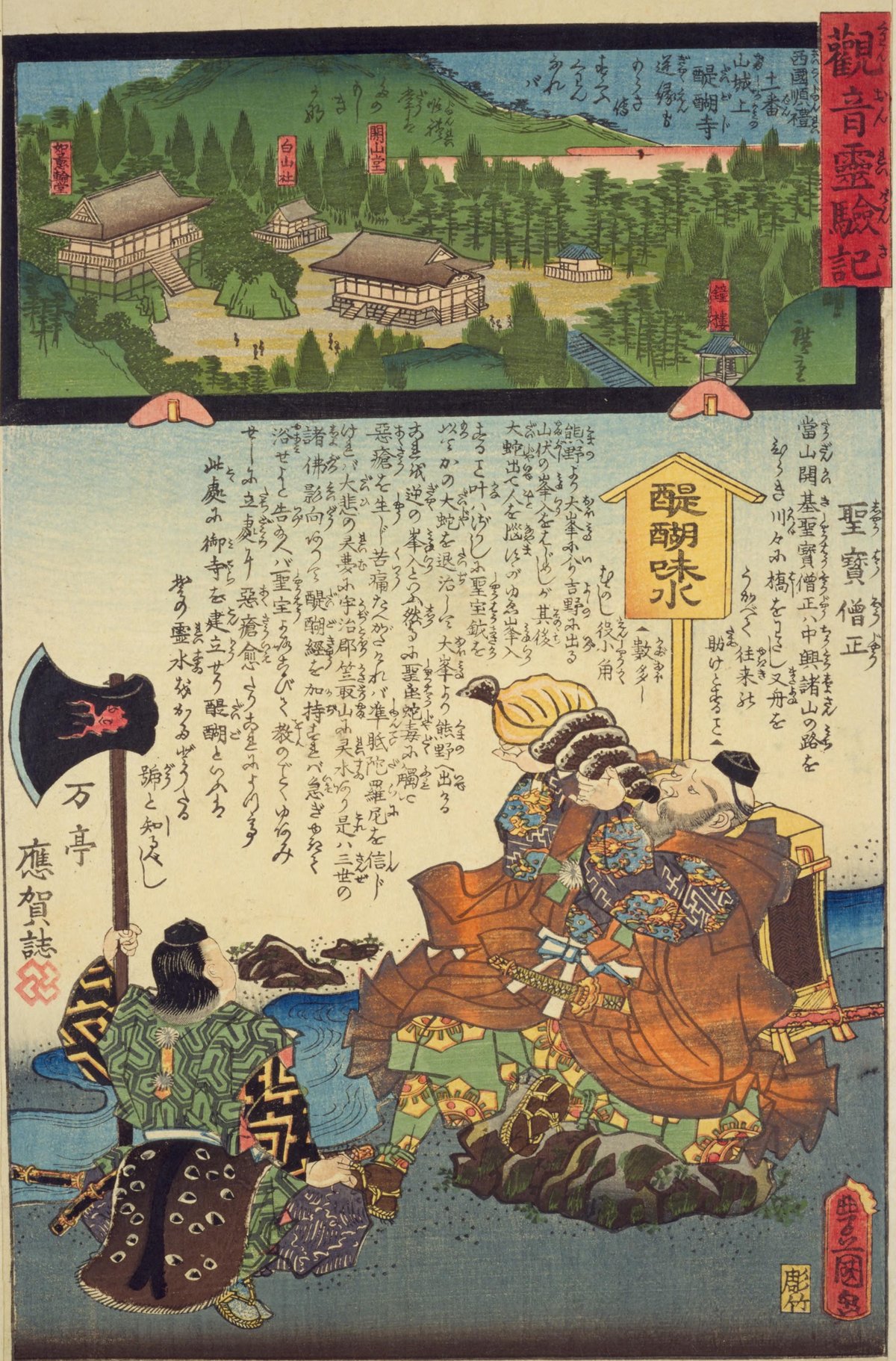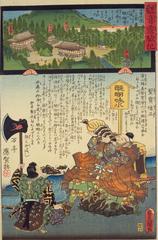
Daigo-ji Kyoto: Visiting Hours, Tickets, and Tourist Guide
Date: 14/06/2025
Introduction to Daigo-ji Temple and Its Historical Significance
Daigo-ji Temple, beautifully situated on Mt. Kami-Daigo in southeastern Kyoto, is an iconic representation of Japan’s Buddhist heritage and imperial history. Founded in 874 CE by the monk Shōbō (Rigen Daishi), Daigo-ji has served as a prominent center for Shingon Buddhism and maintained close ties with the Japanese imperial family, especially Emperors Daigo and Suzaku (Discover Kyoto; Daigoji Official History). The temple’s name, “Daigo,” meaning “the essence,” reflects its role as a custodian of spiritual wisdom and cultural treasures.
The sprawling complex is organized into Shimo-Daigo (Lower Precinct) and Kami-Daigo (Upper Precinct), each home to architectural landmarks, sacred halls, and serene gardens. Daigo-ji’s five-storied pagoda, constructed in 951, is the oldest original wooden building in Kyoto, while the Sanbō-in gardens, redesigned for Toyotomi Hideyoshi’s legendary 1598 cherry blossom party, remain a seasonal highlight (Wa-Pedia; KVG Kyoto). The temple is also famed for its vast collection of cultural artifacts, National Treasures, and Important Cultural Properties, many displayed in the Reihōkan Museum.
Whether you are seeking historical depth, religious insight, or natural beauty, Daigo-ji offers an immersive experience that connects the spiritual, cultural, and seasonal wonders of Kyoto (Japan Guide; Klook).
Contents
- Introduction
- Origins and Early Development
- Architectural and Artistic Heritage
- Historical Turbulence and Restoration
- Religious and Cultural Significance
- Daigo-ji and the Cherry Blossom Tradition
- Visiting Daigo-ji: Hours, Tickets, and Tips
- Temple Grounds and Spatial Organization
- Seasonal Highlights and Special Events
- Practical Visitor Information
- Architectural and Artistic Treasures
- Notable Experiences
- Frequently Asked Questions (FAQ)
- Visitor Information and Recommendations
- Safety and Etiquette
- Conclusion
- Sources
Origins and Early Development
Daigo-ji traces its origins to 874 CE, established by Shōbō, who chose the sacred spring, Daigo-sui, atop Mt. Kami-Daigo for its spiritual potency (Discover Kyoto; Daigoji Official History). This spring inspired the temple’s name and remains a revered site today. Early imperial support—particularly from Emperors Daigo, Suzaku, and Murakami—enabled the construction of key halls, such as the Yakushi Hall (907), Godai Hall, and the five-storied pagoda (951).
Architectural and Artistic Heritage
Daigo-ji’s complex is divided into three main areas: Sambō-in, Shimo-Daigo (Lower Daigo), and Kami-Daigo (Upper Daigo) (Wikipedia). The five-storied pagoda, completed in 951, is a National Treasure and the oldest surviving wooden structure in Kyoto (KVG Kyoto). Sambō-in, reconstructed in 1598, showcases Momoyama architecture and a celebrated landscape garden. The Reihōkan Museum preserves thousands of artifacts, including Buddhist mandalas, statuary, and historic documents, many of which are designated National Treasures (Daigoji Official History).
Historical Turbulence and Restoration
Daigo-ji has endured fires, wars, and periods of decline. The Ōnin and Bunmei Wars (1467–1477) destroyed much of Kyoto, sparing only the pagoda in Shimo-Daigo (Wikipedia). Restoration efforts, patronized by the Minamoto clan and later by Toyotomi Hideyoshi, ensured the temple’s revival. Key halls like the Kondō and Kaisan-dō were rebuilt in the early 17th century, maintaining Daigo-ji’s prominence as a spiritual and cultural center (Daigoji Official History).
Religious and Cultural Significance
A principal temple of the Shingon Ono school, Daigo-ji is a center for esoteric Buddhist study and practice (Wikipedia). It is also an important stop on the Kansai Kannon Pilgrimage and the burial site of Emperor Suzaku. The temple’s teachings and rituals remain vital, with spiritual events held throughout the year.
Daigo-ji and the Cherry Blossom Tradition
Daigo-ji’s gardens are renowned for cherry blossoms in spring and vibrant maple foliage in autumn (Discover Kyoto; Visit Inside Japan). Toyotomi Hideyoshi’s grand hanami in 1598, “Daigo no hanami,” remains legendary and is commemorated annually with parades and festivals (Wikipedia). The symbolism of the cherry blossom—beauty, impermanence, and renewal—resonates deeply with the temple’s spiritual ethos.
Visiting Daigo-ji: Hours, Tickets, and Tips
- Visiting Hours: 9:00 AM to 5:00 PM (last admission 4:30 PM); hours may vary during special events—check the official website for updates.
- Tickets: General admission is typically ¥600, with combined or special event tickets available. Prices and access may vary by season and area (Wa-Pedia).
- Accessibility: Lower precincts are mostly accessible; Kami-Daigo requires a strenuous hike.
- Guided Tours: Available in multiple languages; book via official channels or local tour providers.
- Special Events: Plan your visit during cherry blossom or autumn foliage festivals for an enhanced experience.
- Nearby Attractions: Fushimi Inari Shrine, Tofuku-ji Temple, and Uji’s Byodo-in are easily accessible.
Temple Grounds and Spatial Organization
Shimo-Daigo (Lower Precinct)
- Niō-mon Gate: Main entrance, guarded by fierce guardian statues (Wa-Pedia).
- Kondō (Main Hall): Spiritual heart, rebuilt in 1600, enshrining Yakushi Nyorai.
- Five-storied Pagoda: Completed in 951, houses ancient mandala paintings (Klook).
- Sanbō-in and Gardens: Head priest’s residence, Momoyama garden masterpiece (Wa-Pedia).
- Reihōkan Museum: Showcases National Treasures and Important Cultural Properties (Daigoji Official).
- Other Halls: Benten-dō (music and eloquence deity), Daikō-dō, Fudō-dō, and more.
Kami-Daigo (Upper Precinct)
- Access: One-hour steep hike; rewarding for tranquility and panoramic views (Klook).
- Juntei-dō: Site of the founder’s original hermitage, houses a hidden Kannon statue (Wa-Pedia).
- Yakushi-dō: Dedicated to the Medicine Buddha.
- Godai-dō: Focus for esoteric rituals.
- Daigo-sui Spring: Sacred spring at the summit (NHK World).
- Other Structures: Seiryū-gū Haiden, Nyoirin-dō, Kaisan-dō.
Seasonal Highlights and Special Events
Spring: Cherry Blossom Season
- Daigo Cherry Blossom Festival (April 1–21): Daytime and night illuminations, historical parade (Daigoji Official).
- Peak Viewing: Late March to early April (Japan Travel Mate).
Summer: Lantern Festival
- Lantern Festival (August 5): Hundreds of lanterns, Buddhist rituals, and music (Daigoji Official).
Autumn: Koyo (Autumn Leaves)
- Autumn Leaves Festival (Mid-November–Early December): Night illuminations, Buddhist chants, and concerts (Daigoji Official).
Winter: New Year’s Eve and Tranquility
- New Year’s Eve Bell Ringing (December 31): Traditional ceremony (Daigoji Official).
- Monthly Flea Market: Held on the 29th (28th in February) (Daigoji Official).
Visiting Daigo-ji Temple: Hours, Tickets, and Must-See Attractions
Getting There
- Subway: Tozai Line to Daigo Station, 10–15 minute walk (Kanpai Japan).
- Bus: Community bus #4 from Daigo Station; Keihan Bus #22/22A from Yamashina Station; Keihan Bus #301 from Kyoto Station (Japan Guide).
- JR Train: Kyoto Station to Yamashina, then subway to Daigo.
Tip: Use public transport; parking is limited (Daigo-ji Official).
Hours and Fees
- Lower Grounds: 9:00–17:00 (Mar–Dec), 9:00–16:30 (Dec–Feb)
- Upper Grounds: 9:00–16:00 (Mar–Dec), 9:00–15:00 (Dec–Feb)
- Admission: ¥1,000–1,500 for main areas; Reihokan Museum ¥500; Kami-Daigo ¥600; combined tickets available (Daigo-ji Official).
Facilities and Accessibility
- Restrooms: Available near entrances and major halls.
- Shops and Cafés: Souvenir shops and tea houses near the entrance and Sanbō-in.
- Flea Market: Held monthly, free to enter (Kyoto To Do).
- Wheelchair Access: Lower grounds mostly accessible; Kami-Daigo not suitable for mobility issues.
Practical Recommendations
- Maps: Pick up at entrance or download from official site.
- Dress: Wear comfortable shoes; dress in layers.
- Hydration: Bring water, especially if hiking.
- Guided Tours: Available in English (Kanpai Japan).
- Nearby Sites: Combine with Zuishin-in, Fushimi Inari, or Tofuku-ji (Kanpai Japan).
- Etiquette: Be respectful, follow photography rules, and carry out all trash.
Frequently Asked Questions (FAQ)
Q: What are Daigo-ji’s visiting hours?
A: Lower grounds: 9:00–17:00 (Mar–Dec), 9:00–16:30 (Dec–Feb). Kami-Daigo: 9:00–16:00 (Mar–Dec), 9:00–15:00 (Dec–Feb).
Q: How much are tickets?
A: ¥1,000–1,500 for main areas; ¥500 for Reihokan Museum; ¥600 for Kami-Daigo; combined tickets available.
Q: Is Kami-Daigo accessible for those with mobility issues?
A: No, the hike is steep and not suitable. Lower grounds are mostly accessible.
Q: Is photography allowed?
A: Yes, in most outdoor areas; restrictions apply inside certain halls and the museum.
Q: When is the best time to visit?
A: Cherry blossom season (late March–early April) and autumn foliage (mid-October–early December).
Summary and Final Tips
Daigo-ji Temple is a living testament to Japan’s spiritual, artistic, and seasonal traditions. From the ancient pagoda and Sanbō-in gardens to vibrant cultural festivals, Daigo-ji provides a profound journey through Kyoto’s history. Plan ahead for tickets and hours, take advantage of guided tours, and immerse yourself in the temple’s gardens and events for a complete experience. Neighboring attractions and the Audiala app can further enrich your Kyoto adventure (Daigoji Official; Japan Travel).
Sources
- Discover Kyoto
- Daigoji Official History
- Wa-Pedia
- Japan Travel Mate
- Kanpai Japan
- Japan Guide
- Klook
- NHK World
- Japan Travel
- Kyoto To Do
- Japan365Days
- WanderOn
- KVG Kyoto
- Visit Inside Japan
- TravelCaffeine











































































